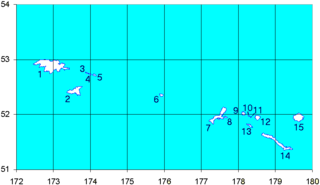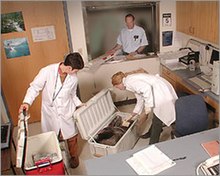
The United States Fish and Wildlife Service is an agency within the United States Department of the Interior dedicated to the management of fish, wildlife, and natural habitats. The mission of the agency is "working with others to conserve, protect, and enhance fish, wildlife, plants and their habitats for the continuing benefit of the American people."

National Wildlife RefugeSystem (NWRS) is a system of protected areas of the United States managed by the United States Fish and Wildlife Service (FWS), an agency within the Department of the Interior. The National Wildlife Refuge System is the system of public lands and waters set aside to conserve America's fish, wildlife, and plants. Since President Theodore Roosevelt designated Florida's Pelican Island National Wildlife Refuge as the first wildlife refuge in 1903, the system has grown to over 568 national wildlife refuges and 38 wetland management districts encompassing about 856,000,000 acres (3,464,109 km2).
A rape kit or rape test kit is a package of items used by medical personnel for gathering and preserving physical evidence following an allegation of sexual assault. The evidence collected from the victim can aid the criminal rape investigation and the prosecution of a suspected assailant. DNA evidence can have tremendous utility for sexual assault investigations and prosecution by identifying offenders, revealing serial offenders through DNA matches across cases, and exonerating those who have been wrongly accused.

Hawadax Island is an island in the Rat Islands archipelago of the western Aleutian Islands in the U.S. state of Alaska. The island was formerly known as Rat Island until May 2012 when it was renamed Hawadax Island, which is an Aleut name meaning "entry" and "welcome". The island has a land area of 10.3126 sq mi (26.7095 km²) and no permanent population. It is within the Alaska Maritime National Wildlife Refuge. It is 9.3 miles (15 km) in length and 3.1 miles (5 km) in width.

The Washington State Patrol (WSP) is the state patrol agency for the U.S. state of Washington. Organized as the Washington State Highway Patrol in 1921, it was renamed and reconstituted in 1933. The agency is charged with the protection of the Governor of Washington and the grounds of the Washington State Capitol; security aboard the vessels and terminals of the Washington State Ferries; law enforcement on interstate and state highways in Washington; and providing specialized support to local law enforcement including laboratory forensic services, mobile field forces during periods of civil unrest or disaster, and tactical teams. The State Fire Marshal's Office, responsible for operation of the Washington State Fire Training Academy and for certain aspects of civil defense mobilization, is a component office of the Washington State Patrol, and the State Patrol is the managing agency of the Washington Fusion Center, which coordinates anti-terrorist and anti-organized crime activities within Washington.
A crime laboratory, often shortened to crime lab, is a scientific laboratory, using primarily forensic science for the purpose of examining evidence from criminal cases.

The Oregon State Police (OSP) is a law enforcement agency of the U.S. state of Oregon. The OSP enforces all of Oregon's criminal laws and assists local law enforcement agencies. Casey Codding has served as Superintendent since February 2023. The agency differs from other state police highway patrol agencies in that OSP has many other areas of specialization and responsibility. In addition to the Patrol Division, OSP has a Criminal Division, SWAT, DPU, MRT, a Forensic Services Division, a Fish and Wildlife Division, a Medical Examiner's Division, an Oregon State Fire Marshal Division, and it is one of the few law enforcement agencies in the United States that monitors the security of the state lottery. Oregon State Police has primary jurisdiction on state highways and all other state owned property. It also frequently responds to incidents in rural areas when local agencies lack capacity or otherwise require assistance.
The following outline is provided as an overview of and topical guide to forensic science:

The California Department of Fish and Wildlife (CDFW), formerly known as the California Department of Fish and Game (CDFG), is a state agency under the California Natural Resources Agency. The Department of Fish and Wildlife manages and protects the state's wildlife, wildflowers, trees, mushrooms, algae and native habitats (ecosystems). The department is responsible for regulatory enforcement and management of related recreational, commercial, scientific, and educational uses. The department also prevents illegal poaching.
The Alaska Department of Fish and Game (ADF&G) is a department within the government of Alaska. ADF&G's mission is to protect, maintain, and improve the fish, game, and aquatic plant resources of the state, and manage their use and development in the best interest of the economy and the well-being of the people of the state, consistent with the sustained yield principle. ADF&G manages approximately 750 active fisheries, 26 game management units, and 32 special areas. From resource policy to public education, the department considers public involvement essential to its mission and goals. The department is committed to working with tribes in Alaska and with a diverse group of State and Federal agencies. The department works cooperatively with various universities and nongovernmental organizations in formal and informal partnership arrangements, and assists local research or baseline environmental monitoring through citizen science programs.

The National Eagle Repository is operated and managed under the Office of Law Enforcement of the United States Fish and Wildlife Service located at the Rocky Mountain Arsenal National Wildlife Refuge outside of Denver, Colorado. It serves as a central location for the receipt, storage, and distribution of bald and golden eagles that have been found dead. Eagles and eagle parts are available only to Native Americans enrolled in federally recognized tribes for use in religious and cultural ceremonies.

Wildlife Crime Control Bureau (WCCB) is a statutory body established by the Government of India under the Ministry of Environment, Forest and Climate Change to combat organised wildlife crime. The Wild Life (Protection) Amendment Act, 2006 provisions came in to force on 6 June 2007. It became operational in the year 2008.
Laurel Neme is an American consultant in environmental and wildlife policy and natural resource management. She is the author of the book Animal Investigators: How the World's First Wildlife Forensics Lab Is Solving Crimes and Saving Endangered Species. She has worked as a consultant for the United States Treasury Department, the World Bank, bilateral donors such as USAID, and non-governmental organizations including the Environmental Defense Fund, the Nature Conservancy, and the World Wildlife Fund.

The United States Fish and Wildlife Service Office of Law Enforcement contributes to Service efforts to manage ecosystems, save endangered species, conserve migratory birds, preserve wildlife habitat, restore fisheries, combat invasive species, and promote international wildlife conservation.
Wildlife forensic science is forensic science applied to legal issues involving wildlife. They also deal with conservation and identification of rare species and is a useful tool for non-invasive studies to determine relatedness of the animals in the area allowing them to determine rare and endangered species that are candidates for genetic rescue using things such as the SSCP or Single-Strand Conformational Polymorphism gel electrophoresis technique, microscopy, DNA barcoding, Mitochondrial Microsatellite Analysis and some DNA and Isotope analysis can identify species and individual animals in most cases if they have already been captured. Unlike human identification, animal identification requires determination of its family, genus, and species, and sex in order to individualize the animal, typically through the use of DNA based analyses.

Rebecca Nicole Johnson is an Australian scientist (geneticist) and science communicator. Since April 2015, Johnson has been Director and Chief Scientist of the Australian Museum Research Institute (AMRI), Sydney, the first female to be appointed to the role since the establishment of the Australian Museum in 1827. She is also head of the Australian Museum's Australian Centre for Wildlife Genomics, a wildlife forensics laboratory based at the Australian Museum.
The Punjab Forensic Science Agency is a government agency under the Home Department, of the provincial Government of Punjab of Pakistan. It provides forensic science services primarily to law enforcement in the province. The Punjab Forensic Science Agency act was passed by the Punjab Assembly on 4 October 2007; assented to by the Governor of Punjab on 29 October 2007; and, was published in the Punjab Gazette (Extraordinary), dated 30 October 2007.
Juliana Machado Ferreira is a Brazilian scientist, a conservation geneticist, and an activist against wildlife trafficking. She is a founding member and current executive director of Freeland Brasil, whose mission is "to conserve biodiversity by ending wildlife trafficking" through the combination of scientific research, education and awareness, and public policy. She is a TED Senior Fellow.












